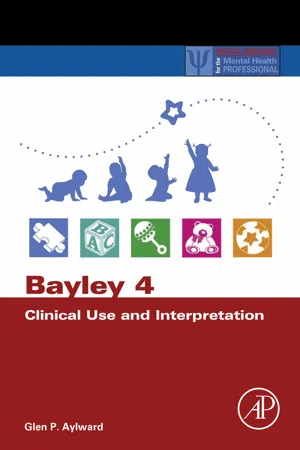
- 200 pages
- English
- ePUB (mobile friendly)
- Available on iOS & Android
Bayley 4 Clinical Use and Interpretation
About this book
Bayley 4 Clinical Use and Interpretation provides clinicians with a guide for use, administration, scoring and interpretation of the Bayley Scales of Infant and Toddler Development, Fourth Edition. The book begins with why and how the Bayley 4 was revised. Separate chapters discuss the clinical use and interpretation of the cognitive, language, motor, social-emotional and adaptive scales, each with illustrative clinical cases. Recommendations are provided to aid clinicians in the efficiency of test administration, as well as how to interpret and integrate results within a diagnostic assessment format and in planning intervention. The clinical validity of the Bayley 4 is demonstrated for eight clinical groups. There is an overview of Autism Spectrum Disorder (ASD) with the Bayley 4 ASD Checklist, accommodations, and red flags indicative of abnormality. Additional chapters discuss digital administration and how to present feedback to caregivers.- Summarizes what is new and different in the Bayley 4- Guides clinicians in use, administration, scoring, and interpretation- Identifies the clinical validity of Bayley 4 for eight clinical groups- Suggests how to integrate results into assessment and intervention- Includes use for autism assessment and an ASD checklist- Provides case studies on typical and atypical development
Frequently asked questions
- Essential is ideal for learners and professionals who enjoy exploring a wide range of subjects. Access the Essential Library with 800,000+ trusted titles and best-sellers across business, personal growth, and the humanities. Includes unlimited reading time and Standard Read Aloud voice.
- Complete: Perfect for advanced learners and researchers needing full, unrestricted access. Unlock 1.4M+ books across hundreds of subjects, including academic and specialized titles. The Complete Plan also includes advanced features like Premium Read Aloud and Research Assistant.
Please note we cannot support devices running on iOS 13 and Android 7 or earlier. Learn more about using the app.
Information
Brain, environment, and development: A synthesis and a conceptual model
Abstract
Keywords
Introduction
Changes from earlier theoretic orientations
Canalization
Neuronal plasticity
Types of neural circuits
Table of contents
- Cover image
- Title page
- Table of Contents
- Copyright
- Foreword
- Introduction
- Chapter 1: Brain, environment, and development: A synthesis and a conceptual model
- Chapter 2: The new test
- Chapter 3: The Cognitive scale
- Chapter 4: Language scale
- Chapter 5: Motor scale
- Chapter 6: Adaptive Behavior Scale
- Chapter 7: Social-Emotional Scale
- Chapter 8: The Autism Spectrum Disorder Checklist
- Chapter 9: Bayley-4 accommodations and modifications
- Chapter 10: Indicators of abnormality (red flags)
- Chapter 11: Clinical group studies
- Chapter 12: The Bayley-4 on Q-global
- Chapter 13: Sample cases
- Chapter 14: Providing feedback
- Chapter 15: The Bayley-4 Screening Test
- References
- Index